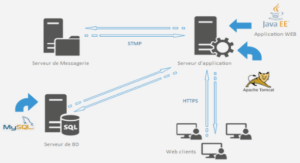Using DSL to Connect to a Central Site
DSL Features
To provide a point of reference throughout the discussions in the chapter, Figure 4-1 illustrates the basic teleworker architecture using DSL. During the course of a phone conversation, a great deal of potential bandwidth is simply not utilized. A wide range of frequencies can coexist on a single copper pair such as is used in an analog phone line. Voice conversations use only a small portion of that available range, usually within the bounds of 300 Hz to 3 kHz. Above that 3 kHz boundary is simply unused space.
POTS Coexistence
Plain old telephone service (POTS) has evolved greatly over the years. When Bell invented the telephone in 1876, he had no idea of the profound effect it would have on the world. In fact, few people initially thought of the invention as having any commercial value. Even the media was more than a little skeptical, stating that well-informed people know that it is impossible to transmit voice over wires. Obviously, they were not so well informed. The telephone has undergone countless changes in both form and function since its rather humble, but highly competitive, beginning. Significant evolutionary steps have come rapidly for the telephone. The related technologies spawned in response, both directly and indirectly, have pushed the imaginations of engineers across the globe. What was once a social status symbol available to relatively few is now as much a part of daily life as clothing and cars. The need for newer, faster, and more effective means of communication along with the demands placed on the industry by the Internet community has driven technologies in new directions. It has also driven a number of very viable inventions into the ground due to cost of implementation or simply being too innovative and ahead of its time. Lessons learned in these types of situations bode well for DSL. The capability of DSL to make use of existing infrastructure while requiring comparatively little in the way of incremental costs is what has allowed it to survive in today’s market. This shared infrastructure has presented challenges to which the engineering and standards bodies have stepped up. The use of existing telephone wiring and varied modulation of signals to allow voice and data to coexist is the very basis of DSL technology. The modulation methods employed in bringing DSL to the CPE router simply exploit existing wires, making use of the untapped frequencies by setting aside channels or carriers for use by downstream and upstream data transfers. A slight change in the way the local loop is provisioned can allow for the previously unused space in the range of 3 kHz to 1.1 MHz to be used for high-speed data service offerings to phone company subscribers. Very little, if any, additional wiring is necessary on the CPE side of the connection. Splitters at both the customer and CO sides of the connection are in charge of combining or dividing the signals as needed based on the direction of the traffic flow. As shown in Figure 4-1, a splitter at the CO redirects the voice traffic to the PSTN switch and out. The data traffic is passed to a DSL access multiplexer (DSLAM). Once the DSLAM receives the signal, it passes the data traffic on to the provider router to traverse the network to which it is connected, in this case, the Internet. To define DSL, it is necessary to be familiar with the terminology used in dealing with it and its associated technological variations. Along with the following terms, some additional attention is given to relevant waveform properties ■ Amplitude—A measure of the magnitude of the oscillation of a waveform. This essentially is the peak height or depth of a wave peak or valley, in relation to the horizontal axis of a graph, during one cycle. ■ ATU-C—ADSL Transmission Unit–central office, a subscriber-facing DSL modem in the provider’s CO. ■ ATU-R—ADSL Transmission Unit–remote, a provider-facing DSL modem in the subscriber home. This could be a DSL-capable router or DSL modem. ■ Downstream—Transmissions from a CO toward a subscriber. ■ DSLAM—A single chassis containing multiple ATU-C units. ■ Frequency—A measure of the number of cycles of a waveform over a given time (typically cycles per second or hertz). Frequency has an inverse relationship to wavelength. As frequency increases, wavelength decreases: Frequency (f) = speed (v) ÷ wavelength (λ)
DSL Limitations
DSL is a relatively distance-sensitive technology. As the distance between the subscriber and their local CO increases, the signal quality and connection speeds decrease. ADSL service is limited to a maximum distance of 18,000 feet (5460 m) between the DSL CPE and the DSLAM, although many ADSL providers place an even lower limit on the distance to ensure quality. The 18,000-foot distance limitation for ADSL is not a limitation for voice telephone calls, but for data transmission. Telephone companies use small amplifiers, called load coils, to boost voice signals. Load coils have a rather nasty tendency to disrupt DSL data signals. This means that if there are load coils in the loop between the CPE and CO, those subscribers are likely not within an area that can receive DSL service. Table 4-2 outlines the distance limitations of some common DSL data-rate offerings. Table 4-2 DSL Distance Limitations DSL Technology Data Rate Downstream/Upstream Maximum Distance ADSL 8 Mbps/1 Mbps 18,000 ft VDSL 55 Mbps/13 Mbps 4,500 ft IDSL 144 kbps/144 kbps 18,000 ft SDSL 768 kbps/768 kbps 22,000 ft G.SHDSL 2.3 Mbps/2.3 Mbps 28,000 ft 150x01x.book Page 85 Monday, June 18, 2007 8:52 AM 86 Chapter 4: Using DSL to Connect to a Central Site As is evident from the table, DSL is offered in a wide range of transfer rates. The table does not represent all available rates. In theory, the maximum throughput potential of any first-generation ADSL technology is 8.448 Mbps. However, that would require a subscriber to be very close (within a few hundred feet) to the local CO. In 2004, the second generation ADSL, known as ADSL2 (ITU G.992 3/4), was created to offer 12 Mbps downstream at distances less than or equal to 8000 feet. Additionally, ADSL2+ (ITU G.992.5) was created to provide up to 24 Mbps for distances less than 5000 feet. Throughput capacity and subscriber distance from the CO are inversely proportional in nature. As distance increases, maximum upstream and downstream speeds decrease. Additionally, other impairments or conditions may contribute to reduced functionality. These include the following: ■ AM radio interference—AM radio frequencies can interfere with DSL signal quality, causing throughput reduction. This is particularly problematic with in-house wiring using low-quality cabling (untwisted or poorly twisted-pair wiring). ■ Bridge taps—These are extensions between the CPE and the CO. Essentially, bridge taps are an additional wire with an unterminated cable end that is connected to the local loop. This causes noise, reflections, and potential for power bleed that reduces signal strength (and therefore throughput). ■ Crosstalk—Crosstalk is interference between two wires in a bundle as a result of electromagnetic interference. Crosstalk occurs when there is frequency overlap between channels. ■ Fiber optic cable—ADSL signals cannot pass through the conversion from analog to digital to analog that occurs if a portion of the telephone circuit traverses fiber optic cable in transit. ■ Impedance mismatch—Impedance mismatch in the local loop causes echo, resulting in noise. The mismatch can be caused by changes in wire gauge, splices, or corrosion. ■ Load coils—Load coils are used to extend the range of a local loop for voice operations. They are intended to function as inductors to compensate for parallel capacitance on the line. Essentially, they are inductors that act like a low-pass filter, disallowing higher frequency signals. Because of this, load coils significantly distort DSL frequencies and must be removed for any DSL operation. They are often found within loops extending farther than 12,000 ft. ■ Signal attenuation—Attenuation is the loss or degradation of signal strength (energy) over distance. Attenuation varies with the distance between subscriber and CO. ■ Wire gauge—Variations in wire thickness can affect throughput by introducing impedance mismatches. Also, the use of thicker wire in the local loop can improve signal strength and improve throughput.
DSL Variants
DSL is available in a number of so-called flavors. Though different in practice or deployment, each of these flavors inevitably falls into one of the following classifications of DSL service: ■ Asymmetrical DSL (ADSL)—Communication in which differing transmission speeds are used for downstream and upstream signals. Typically, downstream speeds tend to be higher than upstream speeds. ■ Symmetrical DSL (SDSL)—Communication in which identical transmission speeds are used for downstream and upstream signals. Overall, the various implementations of DSL are grouped under a single, quite general term, xDSL. The following sections describe the implementations of DSL that are classified as either ADSL or SDSL. Asymmetric DSL Types ADSL is most commonly deployed in the current broadband market where DSL is offered. The following are the different flavors of DSL currently available: ■ ADSL—The full-rate offering of ADSL, which can be configured to deliver from 1.5 to 8 Mbps downstream and 16 kbps to 1 Mbps upstream over a local loop up to 18,000 feet in length. ADSL enables voice and high-speed data to be sent simultaneously over the existing telephone line. ITU-T Recommendation G.992.1 and ANSI Standard T1.413-1998 specify full-rate ADSL. ■ G.Lite ADSL—Known as splitterless ADSL, an ITU standard specifically developed to meet the “plug-and-play” requirements of the consumer market segment. G.Lite is a mediumbandwidth version of ADSL that allows up to 1.5 Mbps downstream and up to 512 kbps upstream, and allows voice and data to coexist on the wire without the use of splitters. G.Lite is a globally standardized (ITU-T G.992.2) interoperable ADSL system. Typical telco implementations currently provide 1.5 Mbps downstream and 512 kbps upstream. ■ RADSL (rate-adaptive DSL)—A nonstandard version of ADSL that automatically adjusts the connection speed to adjust for the quality of the telephone line. This allows RADSL to function over longer distances than ADSL. Note, however, that standard ADSL also permits the ADSL modem to adapt speeds of data transfer. ■ VDSL (very-high-bit-rate DSL)—Provides 13 to 55 Mbps, over distances up to 4500 feet on short loops, such as from fiber to the curb. In most cases, VDSL lines are served from neighborhood cabinets that link to a central office via optical fiber. VDSL can also be configured in symmetric mode. Cisco Long Reach Ethernet (LRE) is based on VDSL technologies.



